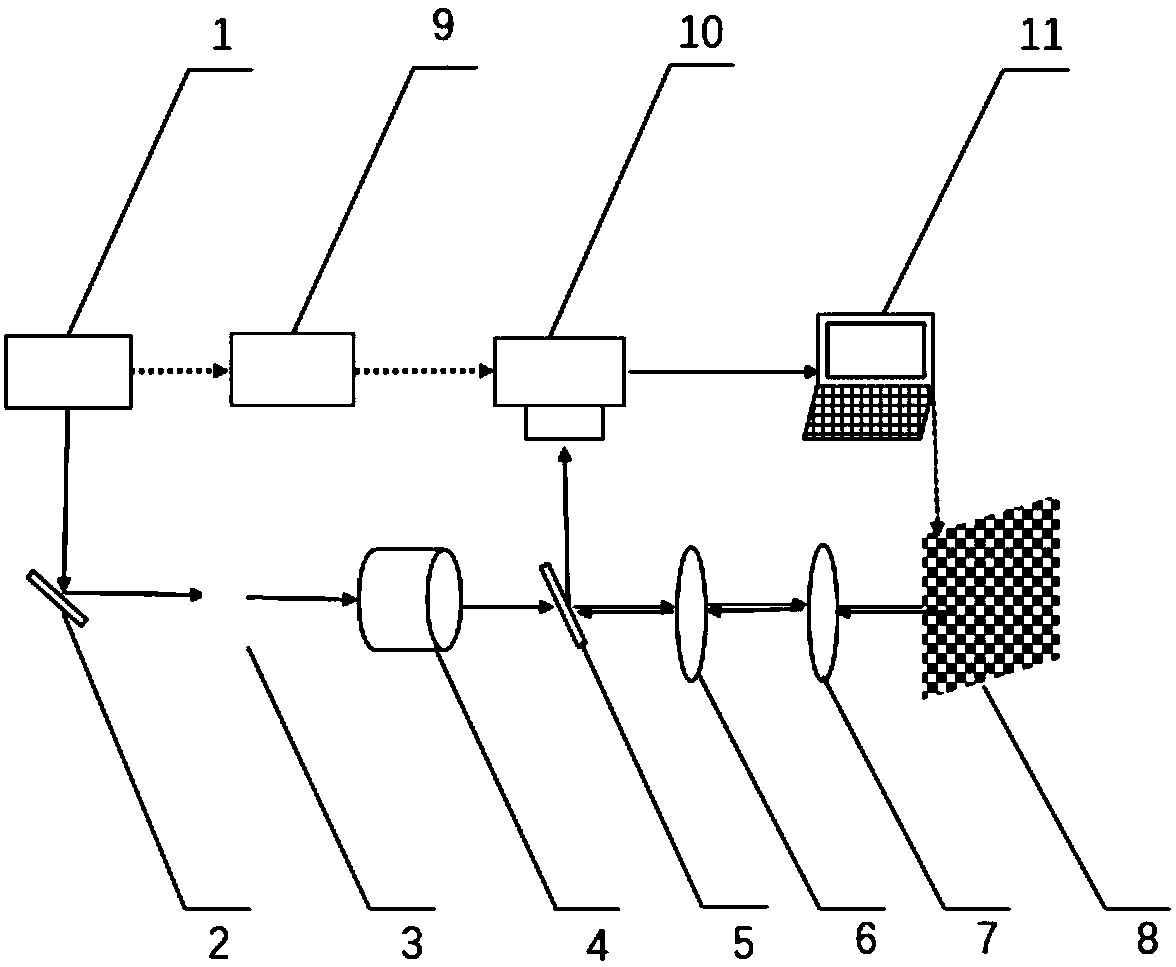Spatiotemporal measurement device for ultrafast laser fields
A measurement device, ultrafast laser technology, applied in the direction of instruments, etc., can solve the problems of loss of time information, loss of spatial resolution of optical information, difficulty in achieving high experimental accuracy, etc.
- Summary
- Abstract
- Description
- Claims
- Application Information
AI Technical Summary
Problems solved by technology
Method used
Image
Examples
Embodiment 1
[0050] refer to Figure 1-2 , figure 2 is the spatiotemporal measurement diagram of the laser field with a center wavelength at 800 nm.
[0051] The laser field 1 to be measured passes through the high mirror 2, the thin paper screen 3, the objective lens 4, and then through the cube beam splitter 5, enters the first convex lens 6, the second convex lens 7, and reaches the digital micromirror device (DMD) 8. The light reflected by the two-convex lens 7 enters the streak camera 10 after reaching the cube beam splitter 5 again;
[0052] The computer 11 is electrically connected to the digital micromirror device 8 and the streak camera 10 respectively, and the digital delay generator 9 is electrically connected to the streak camera 10 and the laser field 1 to be measured respectively.
[0053] The laser field 1 is coded by the digital micromirror device 8 and then reaches the streak camera 10. The streak camera 10 deflects and superimposes it to obtain a forward compressed ima...
Embodiment 2
[0058] refer to figure 1 , image 3 , image 3 It is the spatio-temporal measurement map of the two-color field laser pulse field.
[0059] in: image 3 d is the experimental condition, the difference is that a piece of BBO crystal is placed in the original optical path, and then a two-color pulse of 400nm and 800nm is generated. Due to effects such as dispersion, the two pulses will have a certain time delay.
[0060] image 3 a is the reconstruction result. Each picture represents the spatial information of the laser field at a certain moment, mainly including the light field distribution on the cross section of the laser field. The reconstruction results will show the process of the two laser fields changing from weak to strong and then weak again. The time scale of the two pulses and the spatial distribution within this time scale are recorded.
[0061] image 3 b is the acquisition number of streak camera in one-dimensional working state.
[0062] image 3 c is...
Embodiment 3
[0064] refer to figure 1 , Figure 4 , Figure 4 It is the spatiotemporal measurement map of supercontinuum laser pulse field.
[0065] in: Figure 4 d is the experimental conditions, the difference is that a convex lens is placed in the original light path to focus the light, and the supercontinuum of water is generated in the cuvette filled with water, and then the supercontinuum is irradiated on the paper screen.
[0066] Figure 4 a is the reconstruction result. On the premise of recording the evolution of the entire spot, it can also be found that the pulse width has been broadened to a certain extent.
[0067] Figure 4 b is the collected data in one-dimensional working state.
[0068] Figure 4 c is the Gaussian fitting of the one-dimensional and two-dimensional results, where the small squares represent one-dimensional data, and the small dots represent two-dimensional data. Similarly, the Gaussian fitting results of the two are very similar. Here, the spatiot...
PUM
 Login to View More
Login to View More Abstract
Description
Claims
Application Information
 Login to View More
Login to View More - R&D
- Intellectual Property
- Life Sciences
- Materials
- Tech Scout
- Unparalleled Data Quality
- Higher Quality Content
- 60% Fewer Hallucinations
Browse by: Latest US Patents, China's latest patents, Technical Efficacy Thesaurus, Application Domain, Technology Topic, Popular Technical Reports.
© 2025 PatSnap. All rights reserved.Legal|Privacy policy|Modern Slavery Act Transparency Statement|Sitemap|About US| Contact US: help@patsnap.com



